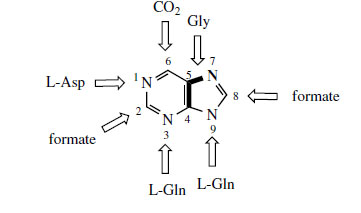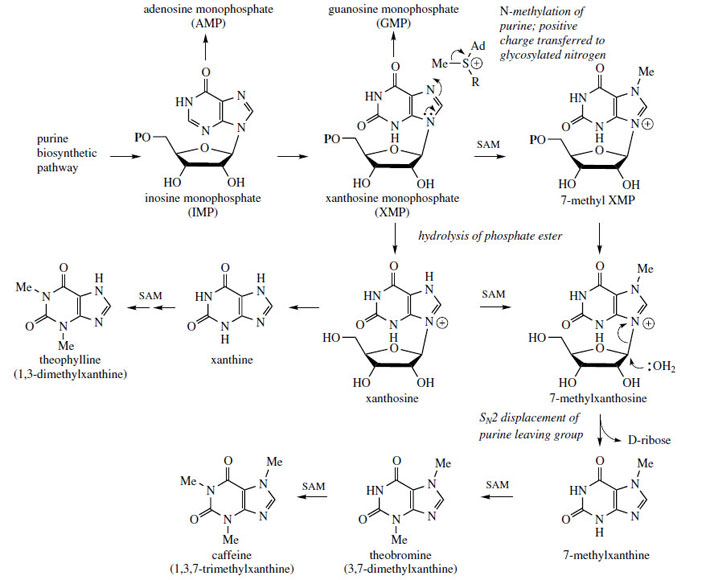Purine Alkaloids
The purine derivatives caffeine, theobromine,
and theophylline (Figure 135) are usually
referred to as purine alkaloids. As alkaloids they
have a limited distribution, but their origins are
very closely linked with those of the purine bases
adenine and guanine, fundamental components of
nucleosides, nucleotides, and the nucleic acids.
Caffeine, in the form of beverages such as tea*
,
coffee*, and cola*
is one of the most widely
consumed and socially accepted natural stimulants.
It is also used medicinally, but theophylline is much more important as a drug compound because
of its muscle relaxant properties, utilized in the
relief of bronchial asthma. Theobromine is a
major constituent of cocoa*, and related chocolate
products. The purine ring is gradually elaborated by piecing together small components from primary metabolism (Figure 134). The largest component incorporated is glycine, which provides a C2N unit, whilst the remaining carbon atoms come from formate (by way of N10-formyl-tetrahydrofolate) and bicarbonate. |
Two of the four nitrogen atoms are supplied by glutamine, and a third by aspartic acid. Synthesis of the nucleotides adenosine 5 -monophosphate (AMP) and guanosine 5 -monophosphate (GMP) is by way of inosine 5 -monophosphate (IMP) and xanthosine 5 - monophosphate (XMP) (Figure 135), and the purine alkaloids then branch away through XMP. Methylation, then loss of phosphate, generates the nucleoside 7-methylxanthosine, which is then released from the sugar. Successive methylations on the nitrogens give caffeine by way of theobromine, whilst a different methylation sequence can account for the formation of theophylline.
 |
| Figure 134 |
 |
| Figure 135 |
Caffeine, Theobromine, and Theophylline
The purine alkaloids caffeine, theobromine, and theophylline (Figure 135) are all methyl derivatives of xanthine and they commonly co-occur in a particular plant. The major sources of these compounds are the beverage materials such as tea, coffee, cocoa, and cola, which owe their stimulant properties to these water-soluble alkaloids. They competitively inhibit phosphodiesterase, resulting in an increase in cyclic AMP and subsequent release of adrenaline. This leads to a stimulation of the CNS, a relaxation of bronchial smoothmuscle, and induction of diuresis, as major effects. These effects vary in the three compounds. Caffeine is the best CNS stimulant, and has weak diuretic action. Theobromine has little stimulant action, but has more diuretic activity and also muscle relaxant properties. Theophylline also has low stimulant action and is an effective diuretic, but it relaxes smooth muscle better than caffeine or theobromine.
Caffeine is used medicinally as a CNS stimulant, usually combined with another therapeutic agent, as in compound analgesic preparations. Theobromine is of value as a diuretic and smooth muscle relaxant, but is not now routinely used. Theophylline is an important smooth muscle relaxant for relief of bronchospasm, and is frequently dispensed in slowrelease formulations to reduce side-effects. It is also available as aminophylline (a more soluble preparation containing theophylline with ethylenediamine) and choline theophyllinate (theophylline and choline). The alkaloids may be isolated from natural sources, or obtained by total or partial synthesis.
It has been estimated that beverage consumption may provide the following amounts of caffeine per cup or average measure: coffee, 30-150 mg (average 60-80 mg); instant coffee, 20-100 mg (average 40-60 mg); decaffeinated coffee, 2-4 mg; tea, 10-100 mg (average 40 mg); cocoa, 2-50 mg (average 5 mg); cola drink, 25-60 mg. The maximal daily intake should not exceed about 1 g to avoid unpleasant side-effects, e.g. headaches, restlessness. An acute lethal dose is about 5-10 g. The biological effects produced from the caffeine ingested via the different drinks can vary, since its bioavailability is known to be modified by the other constituents present, especially the amount and nature of polyphenolic tannins.
Coffee
Coffee consists of the dried ripe seed of Coffea arabica, C. canephora, C. liberica, or other Coffea species (Rubiaceae). The plants are small evergreen trees, widely cultivated in various parts of the world, e.g. Brazil and other South American countries, and Kenya. The fruit is deprived of its seed coat, then dried and roasted to develop its characteristic colour, odour, and taste. Coffee seeds contain 1-2%of caffeine and traces of theophylline and theobromine. These are mainly combined in the green seed with chlorogenic acid (5-7%), and roasting releases them and also causes some decomposition of chlorogenic acid to quinic acid and caffeic acid. The nicotinic acid derivative trigonelline is present in green seeds to the extent of about 0.25-1%; during roasting, this is extensively converted into nicotinic acid (vitamin B3,. Volatile oils and tannins provide odour and flavour. A proportion of the caffeine may sublime off during the roasting process, providing some commercial caffeine. Decaffeinated coffee, containing up to 0.08% caffeine, is obtained by removing caffeine, usually by aqueous percolation prior to roasting. This process provides another source of caffeine.
Tea
Tea is the prepared leaves and leaf buds of Camellia sinensis (Thea sinensis) (Theaceae), an evergreen shrub cultivated in China, India, Japan, and Sri Lanka. For black tea, the leaves are allowed to ferment, allowing enzymic oxidation of the polyphenols, whilst green tea is produced by steaming and drying the leaves to prevent oxidation. During oxidation, colourless catechins (up to 40% in dried leaf) are converted into intensely coloured theaflavins and thearubigins. Oolong tea is semi-fermented. Tea contains 1-4% caffeine, and small amounts (up to 0.05%) of both theophylline and theobromine. Astringency and flavour come from tannins and volatile oils, the latter containing monoterpene alcohols (geraniol, linalool) and aromatic alcohols (benzyl alcohol, 2-phenylethanol). Theaflavins are believed to act as radical scavengers/antioxidants, and to provide beneficial effects against cardiovascular disease, cancers, and the ageing process generally. Tea leaf dust and waste is a major source of caffeine.
Cola
Cola, or kola, is the dried cotyledon from seeds of various species of Cola (Sterculiaceae), e.g. C. nitida and C. acuminata, trees cultivated principally in West Africa and the West Indies. Seeds are prepared by splitting them open and drying. Cola seeds contain up to 3% caffeine and about 0.1% theobromine, partly bound to tannin materials. Drying allows some oxidation of polyphenols, formation of a red pigment, and liberation of free caffeine. Fresh cola seeds are chewed in tropical countries as a stimulant, and vast quantities of dried seeds are processed for the preparation of cola drinks, e.g. Coca-Cola and Pepsi-Cola.
Cocoa
Although cocoa as a drink is now rather unfashionable, it provides the raw material for the manufacture of chocolate and is commercially very important. Cocoa (or cacao) is derived from the roasted seeds of Theobroma cacao (Sterculiaceae), a tree widely cultivated in South America and West Africa. The fruits develop on the trunk of the tree, and the seeds from them are separated, allowed to ferment, and are then roasted to develop the characteristic chocolate flavour. The kernels are then separated from the husks, ground up, and processed in various ways to give chocolate, cocoa, and cocoa butter.
Cocoa seeds contain 35-50% of oil (cocoa butter or theobroma oil), 1-4% theobromine and 0.2-0.5% caffeine, plus tannins and volatile oils. During fermentation and roasting, most of the theobromine from the kernel passes into the husk, which thus provides a convenient source of the alkaloid. Theobroma oil or cocoa butter is obtained by hot expression from the ground seeds as a whitish solid with a mild chocolate taste. It is a valuable formulation aid in pharmacy where it is used as a suppository base. It contains glycerides of oleic (35%), stearic (35%), palmitic (26%), and linoleic (3%) acids.
Mate� Tea
Mate� tea is consumed in South America as a stimulant drink. Mate� or Paraguay tea consists of the leaves of Ilex paraguensis (Aquifoliaceae), South American shrubs of the holly genus. The dried leaf contains 0.8-1.7% caffeine and smaller amounts of theobromine (0.3-0.9%) with little or no theophylline. Considerable amounts (10-16%) of chlorogenic acid are also present.
Guarana
The seeds of the Brazilian plant Paullinia cupana (Sapindaceae) are used to make a stimulant drink. Crushed seeds are mixed with water to a paste, which is then sun dried. Portions of this are then boiled with hot water to provide a refreshing drink. The principal constituent, previously called guaranine, has been shown to be identical to caffeine, and the seeds may contain 3-5%. Small amounts of theophylline (0-0.25%) and theobromine (0.02-0.06%) are also present. Guarana is widely available as tablets and capsules, or as extracts, in health food shops where it is promoted to relieve mental and physical fatigue. Labels on such products frequently show the active constituent to be guaranine, but may not indicate that this is actually caffeine.




